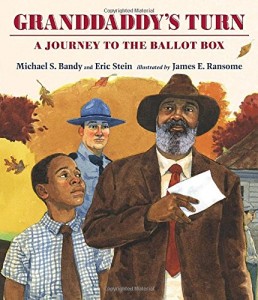Written by Michael S. Bandy and Eric Stein
Illustrated by James E. Ransome
With recent challenges to voting rights by some states, it’s important to keep in mind the history of civil rights struggles. The Founding Fathers only guaranteed voting rights for white male landowners over 21. Slowly, the barriers have come down, but not without challenges. In the 1950s, many states were forced to allow blacks to vote, but many found a way around that by making requirements such as the so-called literacy test. Poll judges were allowed to randomly (meaning for blacks only) present potential voters with complicated texts and require them to interpret the text.
In this beautifully and vividly illustrated picture book, the authors tell of a black farmer trying to vote for the first time. When he is turned away, his grandson understands the fervent hope of his granddaddy and vows to vote in his granddaddy’s place one day. With references to the hard work granddaddy does and the loving guidance Granddaddy provides, the reader can identify with the characters and sense the importance of the vote. The tears Granddaddy sheds at being denied his rights is a great touch.
Second grade readers will learn a lot about civil rights history and citizenship. Although this is fiction, it could be anyone’s story.
 Title: Granddaddy’s Turn: A Journey to the Ballot Box
Title: Granddaddy’s Turn: A Journey to the Ballot Box- Author: Michael S. Bandy and Eric Stein
- Illustrator: James E. Ransome
- Published: Candlewick, 2015
- Reviewer: Sue Poduska
- Format: Hardcover, 32 pages
- Grade Level: 1 to 4
- Genre: Fiction, History, Diversity
- ISBN: 978-0-7636-6593-7
- Extras: Author’s Note

